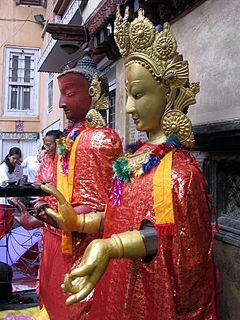Gunlā | |
|---|---|
 Statues of Dipankara Buddha on display during Gunlā in Kathmandu | |
| Also called | Gunlā Parva in Nepali |
| Observed by | Nepalese Buddhists |
| Type | Religious |
| Significance | Celebrates rains retreat started by the Buddha |
| Observances | Image displays, musical processions, alms distribution, fasting, prayer |
Gunlā (Nepal Bhasa: गुंला) (also spelt Gumlā) is the tenth month in the Nepal Sambat lunar calendar, the national lunar calendar of Nepal.[1] It corresponds to August of the Gregorian Calendar.
Gunla is a holy month for Newar Buddhists when they recite the scriptures, observe fasts and visit places of worship playing devotional music. It is one of the most important events in Newar Buddhism.[2][3] The practice of observing the sacred month is descended from the rains retreat dating from the Buddha's time when monks are to stay in one place and taught the Dhamma to the locals during this period.[4][5]
According to traditional beliefs, during primitive times, too much rain would fall. Due to this rain, the mud houses during the time would get devastated, moreover floods and landslides would add melancholy in people's lives. So, in order to downturn the melancholy, and be safe from floods and landslides, people would go to Swayambhu playing the devotional music as it was in an elevation.[6]
- ^ "Nepal Sambat gets national status". The Rising Nepal. 24 October 2008. Archived from the original on 20 October 2013. Retrieved 18 May 2014.
- ^ Locke, John K. (2008). "Unique Features of Newar Buddhism". Nagarjuna Institute of Exact Methods. Archived from the original on 24 March 2012. Retrieved 5 August 2012.
- ^ Lewis, Todd T. (January 1996). "Notes on the Uray and the Modernization of Newar Buddhism" (PDF). Contributions to Nepalese Studies. Retrieved 5 August 2012. Page 111.
- ^ LeVine, Sarah and Gellner, David N. (2005) Rebuilding Buddhism: The Theravada Movement in Twentieth-Century Nepal. Harvard University Press. ISBN 978-0-674-01908-9. Page 64. Retrieved 5 August 2012.
- ^ Lewis, Todd T. (Winter 1993). "Contributions to the Study of Popular Buddhism: The Newar Buddhist Festival of Gumla Dharma". Journal of the International Association of Buddhist Studies. Retrieved 19 February 2013. Page 323.
- ^ Gurju. Ashok Bajracharya, Swayambhu
© MMXXIII Rich X Search. We shall prevail. All rights reserved. Rich X Search
